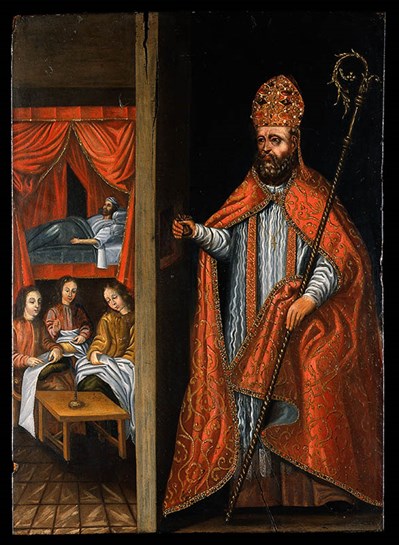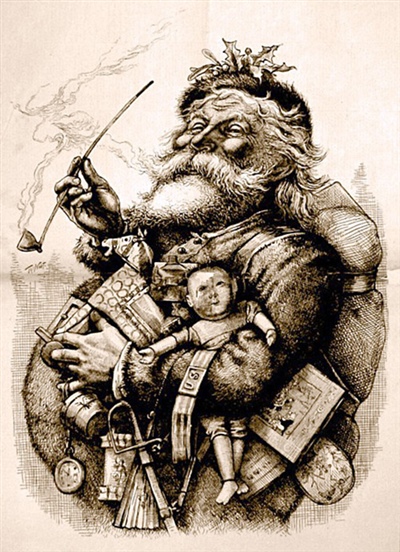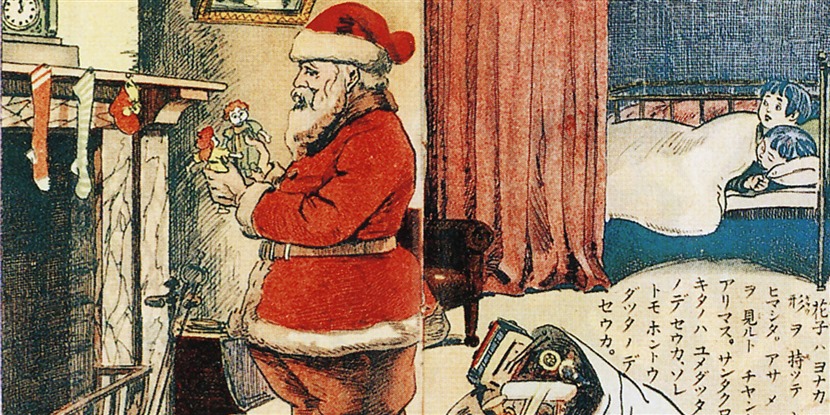By Trevor Getz
San Francisco, USA
Editor's Note: We’re bringing you some historical holiday cheer and re-publishing this blog post alongside a new lesson plan on teaching change and continuity over time (CCOT). Visit our one-stop shop for all things CCOT to find an introductory lesson, a collection of teaching tools, advice from educators, and even a downloadable bookmark to help your students as they practice their analysis skills!
And if you’re looking to inject some CCOT and historical analysis into the holidays (aren’t we all?), this blog will bring you joy!
History, it is sometimes claimed, is the study of continuity and change over time (CCOT). Most historians and teachers demote CCOT to just one among several core competencies in the formal study of the past. They place it alongside other skills with labels like sourcing, historical empathy, comparison, and causation. Even put in its place among complementary skills, the ability to use evidence to determine and describe what changed across a period of time remains a very important competency. As folks who have seen some history firsthand, we teachers also know that understanding what doesn’t change is pretty important.
But our students haven’t seen as much history as us, and I sometimes think that from their point of view, history is all about change. They live in a fast-paced and media-rich world. Personally, they are changing rapidly, and they’re trying to prepare for dramatically different lives in the future. Technology changes, there’s a new meme to engage every day, new classes every semester, and—it must sometimes seem to them—a fresh crisis to face on a weekly basis. Against all these changes, there is just one thing that doesn’t change: tradition.
Tradition, after all, is literally the opposite of change. Tradition means the stuff we do today that we did last year, or a generation ago, or in the distant past. Traditions are an island of stability in a sea of transformation. With traditions, you know what to expect. Tradition is like watching an episode of Friends, or The Office, after a long day at work. It’s comforting and solid and reassuring.
So, I’m almost afraid to tell my students that tradition is no such thing. Traditions are invented. People rework them. They live and die and live again. Traditions are as much about change as they are about continuity.
Today, I’m going to mess with some of our most important traditions: the winter holidays.
First, let’s ruin Christmas. But not quite. I’m not going to tell anyone there’s no such thing as Santa Claus. I will say “Yes, Virginia. There is a Santa Claus: but only because you helped create him in 1897.”[1] The first Christmas celebrations did not have a Saint Nick, because he had not lived yet. He is probably based on a kind, holy man who was born in Anatolia in 270 CE. His life predates the first recorded celebration of Christmas, which took place in Rome in 354 CE. It may be surprising that the Christian church waited more than 300 years to really celebrate the birth of Jesus Christ, which probably took place in 6 or 4 BCE, but birthdays didn’t have a major significance in the Greek and Roman worlds in this period. Instead of celebrating Christ’s birthday, Jesus’s early followers celebrated his baptism and honored his death.
 Kindly Saint Nicholas giving gifts. Even in the eighteenth century, when this image was painted, he looked nothing like our Santa Claus today. But, although his image changed, his identification as a gift-giver remained consistent. By Wellcome Collection, CC BY 4.0.
Kindly Saint Nicholas giving gifts. Even in the eighteenth century, when this image was painted, he looked nothing like our Santa Claus today. But, although his image changed, his identification as a gift-giver remained consistent. By Wellcome Collection, CC BY 4.0.
However, by the time of Saint Nicholas, Christmas had become a useful propaganda tool in the competition for followers (or souls). To win converts, Christians in this period began to celebrate Christ’s birth in competition with the pagan holiday of Saturnalia. Saturnalia was all about fun and food and parties. Christians initially presented Christmas as an alternative vision, a time more about reflection, worship, and good behavior. But although this message allowed Christians to show off their virtue, it didn’t have great mass appeal. So elements of fun were added, in particular the giving of gifts. By the twelfth century, services were often followed by a carnival of games and eating.
Christmas became increasingly important in western Europe as the Church’s moral authority and political power grew. It also became a big deal to the east, where the Byzantine Orthodox church celebrated Christmas. In this faith, though, fasting and privation were emphasized, and no gifts were given until much later.
Across the Christian world the importance of Christmas gradually expanded, but unevenly and not always in the same ways. Christmas gradually assumed importance for Ethiopian Christians, but they celebrated in January. Later, Italian influence and colonialism brought the December dates to Ethiopia.
Rather than give up their January Christmas, many Ethiopians began to celebrate twice (lucky!). In England, it was a big deal until Protestant reformers led by Oliver Cromwell banned it in 1645. It was similarly outlawed by the Puritans in Boston from 1659 to 1681. But it was too popular to keep down for long.
It was the English who popularized many of the elements of what we know as Christmas today, but many of those traditions actually have German origins. How is that possible? Well, Britain’s Queen Victoria married a German prince, Albert of Saxe-Coburg and Gotha, in 1840. Albert brought his German Christmas traditions to England, including putting a tree in the house and decorating it. He also sent trees to schools and military installations. Soon, it was a big deal!
Victoria and Albert gave their children gifts, but it was Americans who really turned Christmas into the biggest gift-giving day of the year. In the nineteenth century, wealthy Americans became concerned that Christmas often turned into a drunken, dangerous night. They wanted people to stay home. So they promoted a child-friendly Christmas that included Santa Claus—a fatter, red-nosed gift-giving man—and lots of presents. And by and large, it worked! By 1897, when Virginia famously asked whether there was a Santa Claus, the answer was a resounding “yes.”
 Thomas Nast’s 1881 “Merry Old Santa Claus”, from Harper’s Weekly. Possibly the illustration that popularized the modern, American image of Santa Claus as a fat, jolly old gift giver. Public domain.
Thomas Nast’s 1881 “Merry Old Santa Claus”, from Harper’s Weekly. Possibly the illustration that popularized the modern, American image of Santa Claus as a fat, jolly old gift giver. Public domain.
As American power grew in the twentieth century, this American vision of Christmas spread around the world, promoted by such brands as Coca-Cola (with huge sales campaigns) and through official diplomatic actions. At home, non-Christians found that they had to compete with Christmas, just as Christians had earlier had to compete with Saturnalia. Jewish communities, for example, looked for a celebration for their own children. They found Hannukah, a relatively minor holiday celebrating Jewish resistance to the rule of the Antiochids in 168 BCE (well before the birth of Christ). Mostly neglected until the late nineteenth century, Hannukah became a big deal in the decades that followed. Starting in the 1920s, gift-giving was added, mirroring the commercialization of Christmas.
A winter holiday also became important to other groups in the US. In 1966, Dr. Maulana Karenga proposed Kwanzaa as a celebration for African Americans who either did not celebrate Christmas or who wanted to add an additional holiday to recognize their roots and culture. Some critics called Kwanzaa a “made-up holiday.” This charge both missed the fact that all holidays are “made up” and evolve over time, and ignored the deep traditional and historical elements that Karenga purposely put into Kwanzaa, reflecting African roots and the traditions that African Americans had built up over generations.[2]
I’m going to end this reflection here, before somebody asks me about Festivus, a holiday created by the writers of Seinfeld (and which isn’t really germane to this essay). My point is simply this: Traditions, even important holidays, change. They change over generations and centuries. They even change year to year. That doesn’t mean that they don’t also have continuities. For example, if you look at Christmas, you can see that although some traditions have been lost along the way, how it is celebrated today is a product of innovations and changes made over the course of more than 1,700 years. Rather than pretending those changes never happened, we should enjoy the richness that continuity and change over time bring to us each December. One way you can do that in your class is by having students work with the OER Project’s CCOT Tool, specifically around a holiday. They could just chart how the holiday has changed in their lifetimes, or interview their parents or grandparents, or even do some research. It ain’t sledding, but it’s still wintertime fun!
[1] Yes, I’m really going to direct you to a Wikipedia page. That’s because I read it, studied it, and I endorse this particular page as an excellent source on this topic. https://en.wikipedia.org/wiki/Yes,_Virginia,_there_is_a_Santa_Claus
[2] http://www.officialkwanzaawebsite.org/
About the author: Trevor Getz is professor of African and world history at San Francisco State University. He has written or edited 11 books, including the award-winning graphic history Abina and the Important Men, and coproduced several prize-winning documentaries. He is also the author of A Primer for Teaching African History, which explores questions about how we should teach the history of Africa in high school and university classes.
Cover image: Santa Claus comes to Japan, 1914. Public domain.
Looking for more? Join us in the OER Project Community today! And if you aren’t registered with us yet, create an account here for free access to the OER Project Community and more.
 For full access to all OER Project resources AND our amazing teacher community,
For full access to all OER Project resources AND our amazing teacher community, 
Top Comments